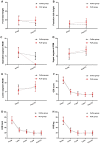A minimum 8-year follow-up comparative study of decompression and coflex stabilization with decompression and fusion
- PMID: 33884033
- PMCID: PMC8056116
- DOI: 10.3892/etm.2021.10027
A minimum 8-year follow-up comparative study of decompression and coflex stabilization with decompression and fusion
Abstract
The current study aimed to compare the outcomes of decompression and interlaminar stabilisation with those of decompression and fusion for the treatment of lumbar degenerative disease (LDD) at a minimum 8-year follow-up. The current study also aimed to analyse the risk factors of radiographic adjacent segment degeneration (ASD). A total of 82 consecutive patients with LDD who underwent surgery between June 2007 and February 2011 were retrospectively reviewed. Of these patients, 39 underwent decompression and Coflex interspinous stabilisation (Coflex group) and 43 underwent decompression and posterior lumbar interbody fusion (PLIF) (PLIF group). All patients had a minimum of 8-years of follow-up data. Radiographic and clinical outcomes were compared between the groups, and the risk factors of developing radiographic ASD were also evaluated. The Oswestry disability index and visual analogue scale leg and back pain scores of both groups significantly improved compared with the baseline (all P<0.05), and no difference were indicated between the two groups at each follow-up time point (P>0.05). The Coflex group exhibited preserved mobility (P<0.001), which was associated with a decreased amount of blood loss (P<0.001), shorter duration of surgery (P=0.001), shorter duration of hospital stay and a lower incidence of ASD (12.8 vs. 32.56%; P=0.040) compared with the fusion group. The current study indicated that coflex and fusion technologies are safe and effective for the treatment of LDD, based on long-term follow-up data. However, Coflex interspinous stabilisation was revealed to reduce ASD incidence. Under strict indications, Coflex interspinous stabilisation is an effective and safe treatment method.
Keywords: adjacent segment degeneration; decompression; fusion; interlaminar stabilisation; lumbar degenerative disease.
Copyright: © Zheng et al.
Conflict of interest statement
The authors declare that they have no competing interests.
Figures



Similar articles
-
Evaluation of Coflex interspinous stabilization following decompression compared with decompression and posterior lumbar interbody fusion for the treatment of lumbar degenerative disease: A minimum 5-year follow-up study.J Clin Neurosci. 2017 Jan;35:24-29. doi: 10.1016/j.jocn.2016.09.030. Epub 2016 Nov 1. J Clin Neurosci. 2017. PMID: 27815024
-
Can low-grade spondylolisthesis be effectively treated by either coflex interlaminar stabilization or laminectomy and posterior spinal fusion? Two-year clinical and radiographic results from the randomized, prospective, multicenter US investigational device exemption trial: clinical article.J Neurosurg Spine. 2013 Aug;19(2):174-84. doi: 10.3171/2013.4.SPINE12636. Epub 2013 May 31. J Neurosurg Spine. 2013. PMID: 23725394 Clinical Trial.
-
Topping-off surgery vs posterior lumbar interbody fusion for degenerative lumbar disease: a comparative study of clinical efficacy and adjacent segment degeneration.J Orthop Surg Res. 2019 Jun 28;14(1):197. doi: 10.1186/s13018-019-1245-3. J Orthop Surg Res. 2019. PMID: 31253158 Free PMC article.
-
Perspective: Efficacy and outcomes for different lumbar interspinous devices (ISD) vs. open surgery to treat lumbar spinal stenosis (LSS).Surg Neurol Int. 2024 Jan 19;15:17. doi: 10.25259/SNI_1007_2023. eCollection 2024. Surg Neurol Int. 2024. PMID: 38344078 Free PMC article. Review.
-
Percutaneously placed lumbar interspinous stabilization devices - a review of current clinical research.Eur Rev Med Pharmacol Sci. 2022 Jun;26(12):4244-4251. doi: 10.26355/eurrev_202206_29061. Eur Rev Med Pharmacol Sci. 2022. PMID: 35776023 Review.
Cited by
-
Comparison of clinical efficacy and radiological findings of interspinous dynamic stabilization system versus unilateral biportal endoscopy for lumbar spinal stenosis: a retrospective cohort study.J Orthop Surg Res. 2025 Apr 29;20(1):427. doi: 10.1186/s13018-025-05859-0. J Orthop Surg Res. 2025. PMID: 40301944 Free PMC article.
-
Effects of dynamic and rigid implantation on biomechanical characteristics of different sagittal alignment lumbar after single- or double-level spinal fixations: a finite-element modeling study.Eur J Med Res. 2023 Dec 11;28(1):583. doi: 10.1186/s40001-023-01475-y. Eur J Med Res. 2023. PMID: 38082343 Free PMC article.
-
Complications and radiographic changes after implantation of interspinous process devices: average eight-year follow-up.BMC Musculoskelet Disord. 2023 Aug 23;24(1):667. doi: 10.1186/s12891-023-06798-9. BMC Musculoskelet Disord. 2023. PMID: 37612739 Free PMC article.
-
Five-year radiological outcomes between decompression alone and decompression with an interlaminar device for lumbar spinal stenosis.J Spine Surg. 2024 Sep 23;10(3):488-500. doi: 10.21037/jss-24-33. Epub 2024 Sep 9. J Spine Surg. 2024. PMID: 39399083 Free PMC article.
-
A novel minimally invasive technique of inter-spinal distraction fusion surgery for single-level lumbar spinal stenosis in octogenarians: a retrospective cohort study.J Orthop Surg Res. 2022 Feb 16;17(1):100. doi: 10.1186/s13018-022-03004-9. J Orthop Surg Res. 2022. PMID: 35172868 Free PMC article.
References
LinkOut - more resources
Full Text Sources
Other Literature Sources
